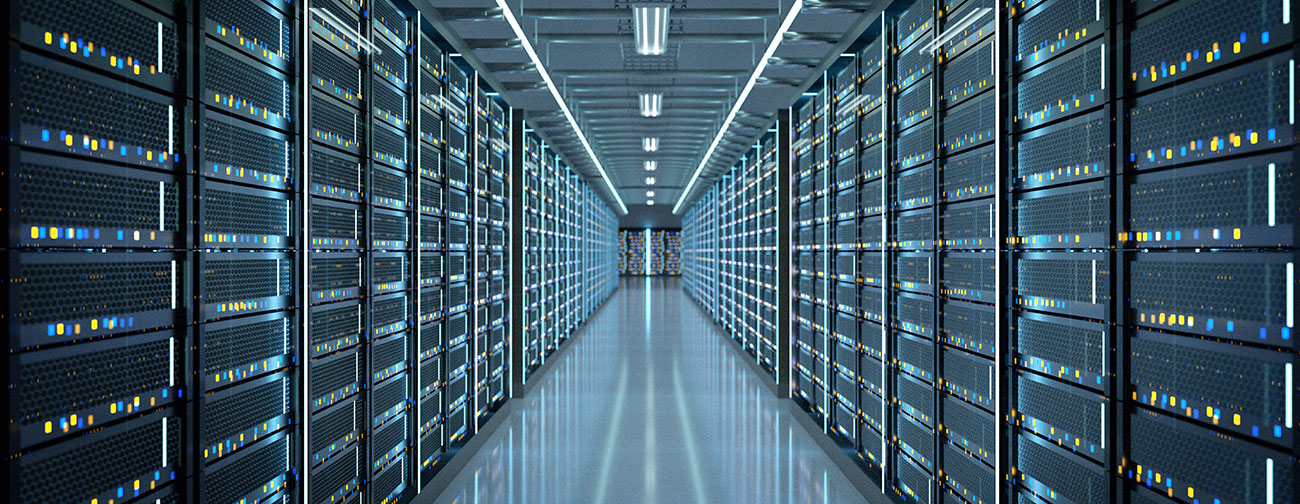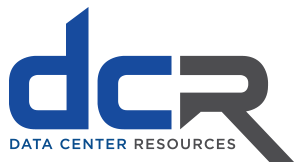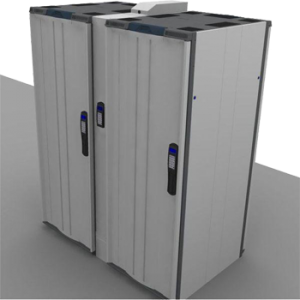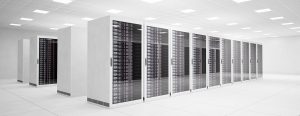Physical Infrastructure Components
The foundation of a data center is its physical infrastructure. Consisting of elements to house, power, cool, and connect an assortment of technology, data center infrastructure also ensures servers, storage devices, and equipment will operate effectively, safely, and with limited disruption. Let’s take a closer look at the infrastructure of a data center.
Racks & Enclosures
The IT equipment within a data center is organized within metal frameworks called racks. Often standardized to be 19 inches in width, racks provide a structured way to vertically stack and secure servers, storage systems, and networking devices. Similarly, enclosures or cabinets are a bit like racks, except they have walls, a door, and additional features for cooling and cable management. Enclosures provide an added layer of protection and security for the data center equipment.
Power Systems
A continuous and stable power supply is crucial to a data center’s operation. Here are some of the power systems that ensure limited interruption:
- Uninterruptible Power Supplies (UPS): These devices provide immediate backup power should the main power source fail and also allots enough time for an orderly shutdown or to switch to generators.
- Power Distribution Units (PDU): PDUs manage and distribute power to the various IT equipment in the racks.
- Backup Generators: If a prolonged power outage takes place, these generators kick in to provide power, ensuring continuous operations.
Cooling Systems
The heat given off by electronic devices can actually reduce device efficiency and lifespan. Because of this, managing and mitigating heat is important.
- Computer Room Air Conditioners (CRAC) & Computer Room Air Handlers (CRAH): Both systems control temperature and humidity in a data center. While CRAC units use refrigerants, CRAH units use chilled water to cool the air.
- Liquid Cooling Solutions: Some high-performance servers and devices use direct liquid cooling, where the coolant circulates directly through the equipment.
- Hot/Cold Aisle Containment: This design approach involves organizing racks in alternating rows where cold air intakes face one aisle and hot air exhausts face another. This design strategy optimizes airflow and reduces energy costs.
Cabling & Connectivity
Every piece of IT equipment in a data center needs to be interconnected through a combination of copper and fiber-optic cables. Proper cable management ensures accessibility, reduces downtime, and prevents issues related to airflow and cooling. To create a tidy and functional layout, strategies like structured cabling neatly bundle and route the cables.
Logical Infrastructure Components
When we talk about data centers, the physical structures—like the racks and cooling units—are only one part of the story. The infrastructure extends to various types of hardware and software that store, process, and transmit data within the data center. Known as logical infrastructure components, these elements are essential for creating seamless data flow, optimizing performance, and boosting service availability.
Servers
If there were a backbone of a data center, it would be the server. Servers are specialized computers designed to handle, process, and store data.
- Rack-mounted Servers: These are standard servers that fit into the vertical racks of a data center.
- Blade Servers: These types are thin, modular servers that slide into a blade enclosure. Overall, blade systems can be more space and energy-efficient than traditional rack-mounted servers.
Storage Solutions
Naturally, with processing data, data storage is critical. However, the type and configuration of storage solutions will depend on the needs of the applications being run.
- Direct-Attached Storage (DAS): This refers to hard drives or storage devices directly attached to a server or a workstation without a network in between.
- Network-Attached Storage (NAS): Contrary to DAS, this dedicated file storage device provides data access to multiple users through a network connection.
- Storage Area Network (SAN): This is a high-speed network of storage devices that can be accessed by multiple servers.
Networking Equipment
For data to be useful, it must be accessible and shareable. Networking components make sure data flows efficiently within the data center as well as to external networks.
- Switches: These devices connect various devices together within a LAN and also use MAC addresses to forward data to the correct destination.
- Routers: Devices that forward data packets between computer networks, guiding data on its journey across the internet or within a data center.
- Load balancers: To ensure no single server has too much demand, these distribute incoming traffic across multiple servers.
- Firewalls: Devices or software that monitor and control incoming and outgoing network traffic based on security policies.
The logical components of a data center are all connected across multiple technologies, almost like a symphony playing together. Their harmonious interaction ensures data is processed, stored, and transmitted efficiently and reliably. As technology continues to evolve, so will the capabilities and complexities of these logical components, pushing the boundaries of what data centers can achieve.
Would you like more info on server rack infrastructure or modular infrastructure, or to receive a quick quote? Contact Data Center Resources today.
Contact Information:
866.740.2121
info@datacenterresources.com





